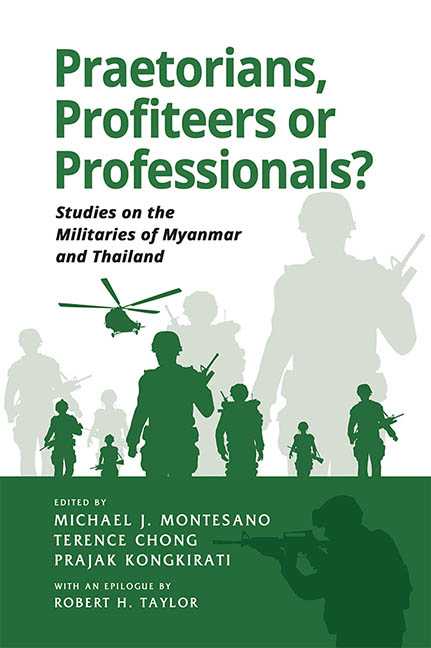Book contents
- Frontmatter
- Contents
- Acknowledgements
- About the Contributors
- 1 Introduction: Two Mainland Southeast Asian Militaries in Comparative Perspective
- 2 A New Tatmadaw with Old Characteristics
- 3 Thailand’s Military: Ideology and Sense of Mission
- 4 The Defence Expenditures and Commercial Interests of the Tatmadaw
- 5 The Economic Role of the Thai Military: A Commercial Logic to Coups?
- 6 Epilogue: Controlling or Playing Politics?
- Index
2 - A New Tatmadaw with Old Characteristics
Published online by Cambridge University Press: 09 October 2021
- Frontmatter
- Contents
- Acknowledgements
- About the Contributors
- 1 Introduction: Two Mainland Southeast Asian Militaries in Comparative Perspective
- 2 A New Tatmadaw with Old Characteristics
- 3 Thailand’s Military: Ideology and Sense of Mission
- 4 The Defence Expenditures and Commercial Interests of the Tatmadaw
- 5 The Economic Role of the Thai Military: A Commercial Logic to Coups?
- 6 Epilogue: Controlling or Playing Politics?
- Index
Summary
“New” and “old” are appropriate words to capture the democratic transition in Myanmar.
In the years after the British left Burma on 4 January 1948, the newly independent nation seemed to number among those with the greatest potential for rapid development. Parliamentary democracy was functioning, and the country's democratic institutions, while still young, were gradually growing stronger. But the period of stability did not last long. On 2 March 1962, the army staged a coup d’état on the pretext of saving the country from disintegration. Repressive rule replaced democracy, and, with first the “Burmese Way to Socialism” and then crony capitalism, the country became an economic backwater. Self-imposed isolation from the 1960s to the 1980s, coupled with international sanctions in subsequent decades, made matters worse. The once promising country lagged far behind many of its Asian neighbours. Today Myanmar is one of the least developed countries in the world.
It took almost half a century for Myanmar to explore democracy again and to rethink the governance structure that had left it impoverished. The military junta designed a new constitution, the third one since independence, which was approved in a nationwide referendum on 29 May 2008. A general election, albeit a rigged one, was held two years later, in November 2010; the military-backed Union Solidarity and Development Party (USDP) won. As a result, a quasi-civilian administration came to power in March 2011. A new political system with separation of powers among the executive branch, the legislature and the judiciary emerged. At last, Myanmar had become free of military dictatorship.
However, old institutions from Myanmar's troubled history were still present. The bureaucracy, run by civil servants of uncertain competence and with former military officers occupying many senior positions, was inefficient. The rule of law remained fragile, as political influence and money continued to influence court decisions. Corruption was rampant. Myanmar was trying to find a new future, but the shadow of the past lingered.
This “new-and-old” and “somewhere-in-between” situation also applies to the country's military. Like other institutions in Myanmar, the armed forces, known as the Tatmadaw, are going through a transformation.
- Type
- Chapter
- Information
- Praetorians, Profiteers or Professionals?Studies on the Militaries of Myanmar and Thailand, pp. 30 - 69Publisher: ISEAS–Yusof Ishak InstitutePrint publication year: 2020

